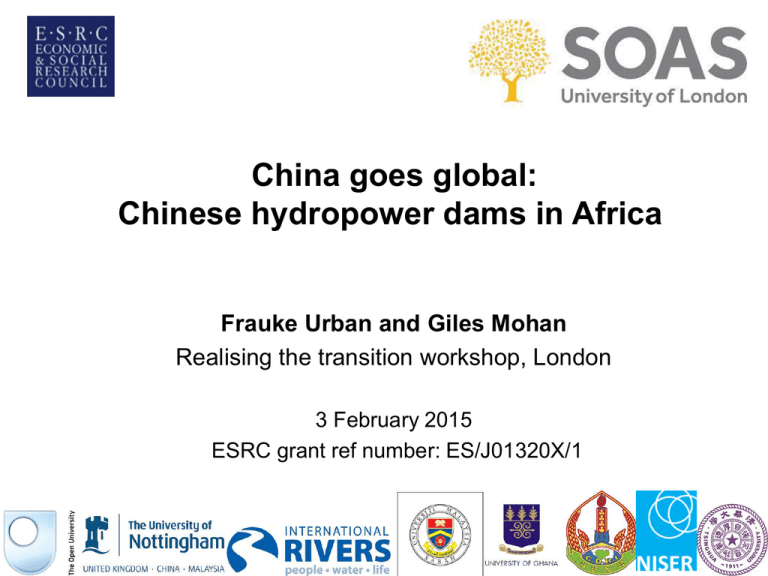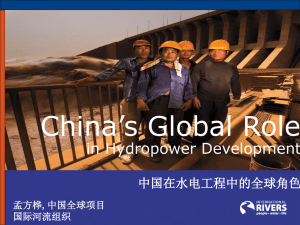A comparative study of Chinese hydropower dams in Africa and Asia
advertisement

China goes global: Chinese hydropower dams in Africa Frauke Urban and Giles Mohan Realising the transition workshop, London 3 February 2015 ESRC grant ref number: ES/J01320X/1 Content 1. China dams the world 2. Project overview 3. Case studies: Bui dam and Zamfara dam 4. Project outlook & conclusion • 1. 1. China dams the world • Global renaissance of hydropower under Chinese leadership • China is the world’s largest hydropower dam builder in terms of number and size of dams built, investment sums and global coverage. • More than 330 Chinese overseas dams, about 40% in Southeast Asia and about 30% in Africa (International Rivers, 2014). • SOE Sinohydro plays major role • Long history of domestic dam-building, but recently many Chinese overseas dams in LMICs - ‘Going Out Strategy’ (Bosshard, 2009; McDonald et al, 2009; International Rivers, 2012) • Chinese domestic dam market is saturated, overseas opportunities for firms, jobs, tax, access to natural resources (McNally et al 2009). Chinese overseas dam projects Chinese builders involved in by location – World regions overseas dam projects 1% 1% 8% 7% 26% Sinohydro (including collaborations with other Chinese builders) Africa 27% Asia 42% Europe Latin America 3% Other Chinese builders (excluding collaboration with Sinohydro) Other non-Chinese builders (but with Chinese contractors) Middle East 28% 57% Pacific Unknown Data from International Rivers, 2014 2. Project aims & methodology • First comparative analysis of the environmental, social, economic and political impacts of Chinese hydropower dam projects in LMICs. • Conceptual framework: ‘Political ecology of the Asian drivers’ • Combining the analysis of power relations over the access to natural resources (Greenberg & Park, 1994; Tan-Mullins, 2007) with assessing China’s impacts as a Rising Power and its channels of interaction with LMICs (Humphrey & Messner, 2005; Schmitz, 2006; Kaplinsky & Messner, 2008) • Themes: Organization and motives of Chinese hydropower actors; local and national impacts; governance implications; UK and OECD interests. 2. Fieldwork sites • Comparative case study analysis: 4 dams, 2 in Africa (Ghana, Nigeria), 2 in SE Asia (Cambodia, Malaysia) and fieldwork in China • Africa: Bui dam, Ghana and ‘Zamfara’ dam, Nigeria • 143 interviews: 71 with institutional actors (policy-makers, firms, NGOs, experts), 72 with affected communities • 40 focus group discussions • 142 household surveys • Stakeholder mappings, data analysis, EIA analysis, literature reviews 3. Case study: Bui dam, Ghana • Located in Northern Ghana on the Black Volta River, within Bui National Park • 400 MW, started operation in 2013 • Built by Sinohydro • Funded by Chinese ExIm Bank, Government of Ghana, Government of China, $620 million, part of trade deal (International Rivers, 2014) • 50% of Ghana’s population below poverty levels of 2$/day (World Bank, 2014) • 30% of Ghanaians do not have access to electricity, 65% cook with traditional biofuels (World Bank, 2014) • Heavy reliance on hydropower for power generation 3. Social and environmental implications: Bui dam • Flooding of 6 villages, 20% of Bui National Park, loss of forest and savannah woodland habitat • Threats to endangered species, such as rare black hippo • Resettlement of 1,216 people, sometimes poor infrastructure in resettlement area • 7,500 people have lost access to parts of farmland, grazing land and forests, loss of access to fishing grounds, negative impacts on livelihoods • Compensation payments and locals took part in consultation meetings, EIA process includes mitigation measures 3. Governance: Bui dam • Bui Power Authority manages dam, resettlements, compensations • Engineering, Procurement and Construction (EPC) / Turn-key Project Contract • Sinohydro is responsible for the construction of the dam and safety of workers, after construction the host government becomes responsible for the dam • ESIA conducted before the dam building started • Compliance with Ghana’s legislation • Still complaints from locals & lack of transparency from Bui Power Authority 3. Case study: Zamfara dam, Nigeria • • • • • • • • Located in Northern Nigeria in Zamfara state, close to Gusau In planning stage, not built Projected generating capacity of 100MW Projected cost about US$160 million, to be financed by ExIm Bank (International Rivers, 2014) Proposed builders, developers and contractors are China Geo-Engineering Corporation CGC 80% of Nigeria’s population below poverty levels of 2$/day (World Bank, 2014) 50% of Nigerians do not have access to electricity, far more cook with traditional biofuels, in some areas up to 80% of the population (World Bank, 2014; IEA, 2014) Insufficient power generation and lack of access to modern fuels, aggravated by challenges of corruption, unequal distribution of wealth & resources, instable security 3. Lost case? The Zamfara dam, Nigeria • Dam not built, but surveys carried out • Local people from 8 villages were consulted, including for resettlement • Dam raises promises for a better life: employments, poverty reduction, infrastructure, water supply, electricity, improved security etc • Stark contrast to the disillusioned views of those who have been affected by Chinese-built dams in Africa and beyond • Dam deal negotiated by ex-governor, power shift means project is shelved • Difficult for smaller firm to negotiate deal with government in unstable political and highly corrupt system • Unstable security situation in Northern Nigeria due to Boko Haram • Overall unlikely that dam will be built in near future 4. Project outlook • • • • • UK / EU donor & firm interviews Data analysis with Nvivo Comparative analysis Writing papers Dissemination events 4. Conclusion • Dams are considered a low carbon energy source & are currently experiencing large growth, partly due to the climate change debate • China is at the forefront of this revival of dams, investing heavily on a global scale • China’s Sinohydro and China ExIm Bank play a large role in financing and building overseas dams, but also smaller players relevant, although with mixed success • The dam-builders’ behaviour towards the local environment, local communities and national legislations is shaped by the governance context set by the host country. • Ghana: set up a comprehensive governance framework and requested Chinese dam-builders to operate according to local legislations and best practice, still major impacts on local population • Nigeria: high hopes of local population for the dam, but slim chances dam will be built, lack of capacity at dam-builder and government level • Realising the low carbon transition? Yes, but the practices of both Chinese dam-builders and host countries need to be improved to increase the sustainability of dams and its local impacts. Thank you for your attention Questions?








